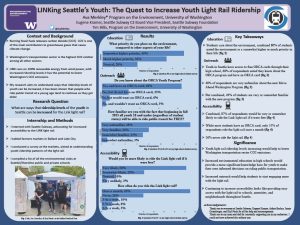Linking Seattle’s Youth: The Quest to Increase Youth Light Rail Ridership
Carbon dioxide (CO2) and other air pollutants plague cities from vehicle emissions. People may develop an array of health issues from exposure to air pollution. Washington state’s CO2 emissions are the highest in the transportation sector among all other sectors. To decrease emissions, mass transit is preferred. Of the various forms of public transportation, light rail systems tend to run on renewable energy and have the capacity to carry many people at once. The key to curbing CO2 emissions from the transportation sector is by increasing and sustaining higher ridership levels on the Link light rail. It is important the youth have access to the Link light rail as the next generation of riders that will benefit most from the completed construction of the light rail system. The purpose of this study was to better understand patterns in youth knowledge and ridership of the Link light rail to highlight points for potential increased ridership. I interned with Seattle Subway, a nonprofit organization advocating for light rail system expansions. I conducted a survey and researched the light rail systems’ environmental context. This helped me conclude that more youth outreach and education are necessary. As well as expanding access to the Link light rail by extending the lines as suggested in Seattle Subway’s ST4 vision map. These three solutions have the potential to increase youth ridership of the Link light rail. Increased ridership of the light rail is the key way that it will be able to maintain an environmental advantage over cars.
